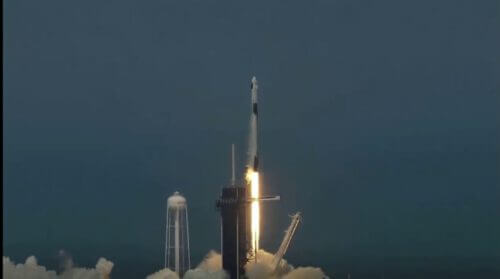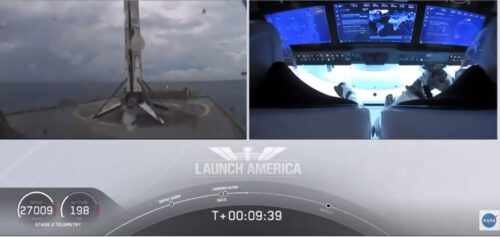Astronauts Robert Behnken and Douglas Hurley are already in orbit around Earth after successfully launching at 15:22 PM EST in the CREW DRAGON spacecraft aboard the Falcon 9 launcher, both developed and built by SpaceX, Elon Musk's private space company

Astronauts Robert Behnken and Douglas Hurley are already in orbit around the Earth after being successfully launched this evening (Saturday) at 15:22 EST (22:22 Israel time) in the CREW DRAGON spacecraft on top of the Falcon 9 launcher. Both were developed and built by SpaceX, a company Elon Musk's private space. This after an attempted launch on Wednesday was canceled due to weather conditions. US President Donald Trump and his deputy Mike Pence, who chairs the US National Space Council, were also present at the launch.
The astronauts will dock at the space station 19 hours after launch, during which they will perform maneuvers and activate the engines that will bring them to the rendezvous. NASA TV will cover the operation until they arrive at the space station here:
The mission, known as NASA's SPACEX DEMO-2, is the final end-to-end test flight of the astronaut shuttle system, thus returning the US to independent launch capability. "Thank you for flying the Falcon 9 today - we hope you enjoy the mission," said SPACEX Chief Engineer Bala Remorti.
So far the docking, navigation and control systems as well as the life support system of the spacecraft are working well. As is customary with SpaceX, even in unmanned launches, the second stage of the launcher landed on a rig in the heart of the Atlantic Ocean to be used for re-launch. This process also went smoothly.

The launch was followed by launch 39A at the Kennedy Space Center in Florida, which was also used for launches in the Apollo missions and the space shuttles.
NASA's Commercial Crew Program was established to integrate the US aerospace industry to facilitate the development of US manned spacecraft. The program was established in 2010 shortly before the ferries were retired. Many delays in the plan meant that only in September 2014 did NASA, Boeing and SpaceX build manned spacecraft that would be used by NASA to bring astronauts to the International Space Station and also be used by private astronaut companies. This is, at least on purpose, to free up NASA's resources to develop the Orion project that will be able to transport astronauts beyond Earth's orbit, and first and foremost - to the moon.
The winning companies committed to build launchers, spacecraft and related systems to transport up to four astronauts to the space station. In this way, it will be possible to return the size of the station's crew to seven astronauts, who will be able to perform more scientific tasks, and reduce the relative part of their time dedicated to station maintenance.
More of the topic in Hayadan:

4 תגובות
Beautiful. And when do they organize a delegation to upgrade the Hubble? With any luck it could come out even before James Webb's launch.
To watch the connection of the spacecraft to the station live:
https://www.youtube.com/watch?v=bIZsnKGV8TE
Finally some fun news
Betrayed not from appendages but in space
Each UFO will receive citizenship of the commercial company and NASA
Can someone please update when according to Israel time they are supposed to connect to the space station?
Thanks.